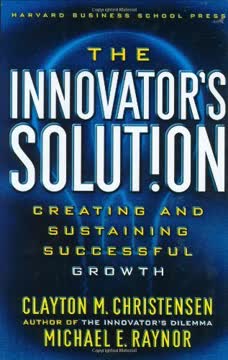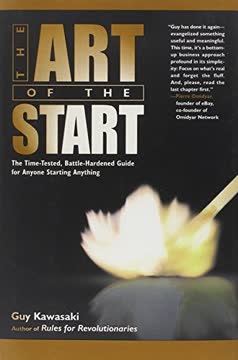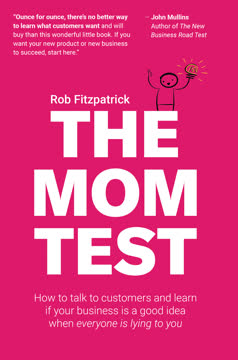Key Takeaways
1. Customer Development: The Key to Startup Success
Customer Development is damn hard work. You can't fake it.
Four-step process. The Customer Development methodology consists of four crucial steps: Customer Discovery, Customer Validation, Customer Creation, and Company Building. This iterative process helps startups discover and validate their target market, refine their product offering, and build a scalable business model.
Contrast with traditional approach. Unlike the traditional product development model, which assumes a known market and customer base, Customer Development acknowledges the uncertainties inherent in startups. It emphasizes learning and discovery over execution, allowing founders to test their hypotheses and adapt quickly based on real customer feedback.
Key principles of Customer Development:
- Get out of the building and talk to real customers
- Test hypotheses through rapid experimentation
- Iterate and pivot based on customer feedback
- Focus on learning and discovery before scaling
2. The Business Model Canvas: A Dynamic Tool for Startups
The difference between a static business plan and a dynamic model could well be the difference between flameout and success.
Visual representation. The Business Model Canvas, developed by Alexander Osterwalder, is a strategic management tool that allows startups to visualize, design, and pivot their business model. It consists of nine key components: Value Proposition, Customer Segments, Channels, Customer Relationships, Revenue Streams, Key Resources, Key Activities, Key Partnerships, and Cost Structure.
Iterative tool. Unlike a static business plan, the Business Model Canvas is designed to be flexible and adaptable. Startups use it as a scorecard throughout the Customer Development process, updating their hypotheses and tracking their progress as they gather real-world data and insights.
Benefits of using the Business Model Canvas:
- Provides a holistic view of the business
- Facilitates quick iterations and pivots
- Encourages cross-functional collaboration
- Helps identify key assumptions and risks
3. Get Out of the Building: Test Your Hypotheses with Real Customers
Facts exist only outside the building, where customers live, so the most important aspect of customer discovery is getting out of the building, in front of customers.
Direct customer interaction. The core principle of Customer Development is that founders must personally engage with potential customers to validate their hypotheses. This means conducting face-to-face interviews, observing customer behavior, and gathering firsthand feedback on the problem and proposed solution.
Avoid assumptions. Many startups fail because they build products based on untested assumptions about customer needs and preferences. By getting out of the building, founders can challenge their own biases and gather real data to inform their decisions.
Key activities when getting out of the building:
- Conduct customer interviews and surveys
- Attend industry events and trade shows
- Observe customers in their natural environment
- Run small-scale experiments to test hypotheses
4. Minimum Viable Product: Start Small, Learn Fast
The goal of the MVP is to build the smallest possible feature set.
Rapid learning tool. The Minimum Viable Product (MVP) is a version of the product with just enough features to gather validated learning about customers and their needs. It allows startups to quickly test their hypotheses and iterate based on real customer feedback, without investing excessive time and resources in full product development.
Iterative development. The MVP approach encourages startups to release early and often, continuously refining their product based on customer interactions. This iterative process helps startups avoid building features that customers don't want or need, and focus on delivering value that solves real problems.
Key principles of MVP development:
- Focus on core features that solve the main customer problem
- Release quickly and gather feedback
- Prioritize learning over perfection
- Iterate based on customer insights
5. Pivot or Persevere: Embrace Failure and Iterate
Failures are not truly failures, per se but an integral part of the startup learning process.
Learning from failure. In the startup world, failure is not only common but expected. The key is to treat failures as learning opportunities and use them to inform future iterations of the business model. Pivoting – making substantial changes to one or more components of the business model – is a natural part of the startup journey.
Data-driven decisions. The decision to pivot or persevere should be based on data gathered through customer interactions and experiments. Startups need to establish clear metrics and milestones to objectively evaluate their progress and determine when a pivot is necessary.
Types of pivots:
- Customer segment pivot
- Value proposition pivot
- Channel pivot
- Technology pivot
- Revenue model pivot
6. Market Type Determines Strategy: Choose Wisely
Market type influences everything a company does.
Four market types. Blank identifies four distinct market types: existing market, resegmented market, new market, and clone market. Each market type requires a different approach to customer development, product positioning, and go-to-market strategy.
Strategic implications. Understanding your market type is crucial for developing an effective strategy. For example, entering an existing market requires clear differentiation and superior performance, while creating a new market demands extensive customer education and longer-term vision.
Characteristics of different market types:
- Existing market: Known customers, competitors, and business models
- Resegmented market: Targeting an underserved niche or low-cost segment
- New market: No existing customers or competitors, requires market creation
- Clone market: Replicating a successful business model in a new geography
7. The Power of Earlyvangelists: Your First Crucial Customers
Earlyvangelists are willing or eager accelerators of your viral growth.
Visionary customers. Earlyvangelists are a special type of customer who are actively looking for a solution to a problem and are willing to take a chance on an early-stage product. They are crucial for startups as they provide valuable feedback, generate early revenue, and can become powerful advocates for the product.
Characteristics of earlyvangelists. Identifying and engaging earlyvangelists is a key task in the Customer Development process. These customers typically have a problem they're actively trying to solve, understand the pain points intimately, and have the budget and authority to make purchasing decisions.
Key traits of earlyvangelists:
- Aware of the problem and actively seeking a solution
- Cobbled together interim solutions
- Have budget allocated for a solution
- Influential within their organization or community
- Willing to take a risk on new technology
8. Metrics that Matter: Focus on What Drives Success
Startup metrics should focus on tracking the startup's progress converting guesses and hypotheses into incontrovertible facts rather than measuring the execution of a static plan.
Data-driven decision making. Startups need to focus on metrics that provide actionable insights and drive business growth. Traditional financial metrics like revenue and profit are often lagging indicators for early-stage startups. Instead, focus on metrics that reflect customer behavior, product-market fit, and the efficiency of the business model.
Key performance indicators. Identify the key metrics that are most relevant to your business model and stage of growth. For web/mobile startups, this might include user acquisition cost, activation rate, retention rate, and customer lifetime value. For physical products, it could be sales cycle length, conversion rates, and customer acquisition cost.
Examples of important startup metrics:
- Customer Acquisition Cost (CAC)
- Lifetime Value (LTV)
- Churn Rate
- Monthly Recurring Revenue (MRR)
- Net Promoter Score (NPS)
9. Web/Mobile Startups: Unique Challenges and Opportunities
Gathering a massive, growing audience efficiently and cost-effectively is job No. 1 for most web/mobile products.
Rapid iteration. Web/mobile startups have the advantage of being able to launch quickly, gather data in real-time, and iterate rapidly based on user feedback. This allows for faster learning and adaptation compared to physical product startups.
User acquisition and activation. For web/mobile startups, the primary challenge is often acquiring and activating users at scale. This requires a deep understanding of user behavior, effective marketing channels, and continuous optimization of the user experience.
Key focus areas for web/mobile startups:
- User acquisition strategies (paid and organic)
- Onboarding and activation optimization
- Retention and engagement tactics
- Viral growth mechanisms
- Monetization strategies
10. The Art of Positioning: Stand Out in the Market
Unsubstantiated superlatives like easiest, best and greatest are meaningless. Demonstrable, provable claims like fastest and cheapest are stronger.
Differentiation is key. Effective positioning helps a startup stand out in a crowded market by clearly communicating its unique value proposition. This involves understanding the competitive landscape, identifying key customer pain points, and articulating how your solution addresses those needs better than alternatives.
Evolving positioning. As startups progress through the Customer Development process, their positioning may evolve based on customer feedback and market insights. It's important to continuously refine your positioning to ensure it resonates with your target audience and accurately reflects your value proposition.
Elements of effective positioning:
- Clear articulation of the problem you solve
- Unique value proposition
- Target customer definition
- Competitive differentiation
- Proof points and credibility builders
Last updated:
FAQ
What's The Startup Owner's Manual about?
- Comprehensive Guide: The Startup Owner's Manual by Steve Blank is a detailed guide for entrepreneurs on building successful startups.
- Customer Development Focus: It emphasizes the importance of understanding customer needs and validating business models through direct customer interaction.
- Structured Approach: The book outlines a structured approach with practical tools and frameworks, such as the Business Model Canvas, to systematically test and refine business ideas.
Why should I read The Startup Owner's Manual?
- Proven Methodology: The book presents a proven methodology that has been adopted by many successful entrepreneurs, reducing the risk of failure.
- Real-World Examples: It includes numerous real-world examples and case studies, making the concepts relatable and easier to understand.
- Actionable Insights: Readers gain practical advice that can be immediately applied to their ventures, making it valuable for both new and experienced entrepreneurs.
What are the key takeaways of The Startup Owner's Manual?
- Customer-Centric Approach: Emphasizes engaging with customers directly to validate assumptions and understand real problems.
- Iterative Learning: Advocates for continuously testing and refining business models based on customer feedback.
- Business Model Canvas: Introduces this tool to visualize and organize business model hypotheses, aiding in tracking progress and making informed decisions.
What is the Customer Development process in The Startup Owner's Manual?
- Four Phases: Consists of Customer Discovery, Customer Validation, Customer Creation, and Company Building.
- Hypothesis Testing: Involves formulating and testing business model hypotheses through direct customer interactions.
- Iterative Feedback Loop: Encourages a feedback loop where customer insights inform subsequent actions and decisions.
How does The Startup Owner's Manual define a Minimum Viable Product (MVP)?
- Core Features Only: An MVP is the simplest version of a product with essential features to solve a core problem for early customers.
- Testing Assumptions: Its purpose is to test assumptions about customer needs and validate the product's value proposition.
- Iterative Improvement: Feedback from MVP users is used to iteratively improve the product, ensuring it meets market demands.
What is the significance of the Business Model Canvas in The Startup Owner's Manual?
- Visual Framework: Serves as a visual tool to outline and organize business model hypotheses.
- Hypothesis Testing: Allows entrepreneurs to track assumptions and validate them through customer feedback.
- Dynamic Document: The canvas evolves as more information and insights are gathered, aiding in navigating startup uncertainties.
What are the common pitfalls startups face according to The Startup Owner's Manual?
- Premature Scaling: Expanding operations before validating the business model can lead to significant cash burn and failure.
- Ignoring Customer Feedback: Believing they know what customers want without listening can result in products that don't resonate.
- Overcomplicating the Product: Adding too many features can dilute the core value proposition and confuse potential buyers.
How does The Startup Owner's Manual suggest handling customer feedback?
- Active Listening: Emphasizes understanding customer needs and pain points rather than pushing the product.
- Iterative Process: Feedback should be used to refine the product and business model continuously.
- Documenting Insights: Encourages systematic documentation of insights to track progress and inform future actions.
What is the importance of earlyvangelists in the startup process according to The Startup Owner's Manual?
- Visionary Customers: Earlyvangelists are visionary customers who recognize significant problems and are eager for solutions.
- Feedback Providers: They provide valuable feedback that helps shape the product and its features.
- Risk Takers: Willing to take risks on new products, they help validate the startup's value proposition and build market momentum.
What are the best quotes from The Startup Owner's Manual and what do they mean?
- "There Are No Facts Inside Your Building, So Get Outside.": Emphasizes the necessity of engaging with customers directly to gather real insights.
- "No business plan survives first contact with customers.": Highlights the unpredictability of the startup journey and the need for flexibility.
- "Failure is an Integral Part of the Search.": Suggests that failure provides valuable learning opportunities in the startup process.
How does The Startup Owner's Manual define market types?
- Four Market Types: Existing markets, new markets, re-segmented markets, and clone markets.
- Impact on Strategy: Each type influences strategy, including customer acquisition, pricing, and competitive positioning.
- Tailored Approaches: Understanding the market type helps tailor the approach to customer discovery and validation.
How do I know when to pivot or proceed with my startup according to The Startup Owner's Manual?
- Data-Driven Decisions: Base the decision on thorough analysis of customer feedback and validation results.
- Key Metrics: Focus on metrics like customer acquisition costs and conversion rates to assess alignment with business expectations.
- Team Consensus: Engage the team and advisors in discussions to ensure alignment and commitment to the chosen direction.
Review Summary
The Startup Owner's Manual receives largely positive reviews, with an average rating of 4.10/5. Readers praise its practical, step-by-step approach to building a successful startup, focusing on customer discovery and validation. Many consider it essential reading for entrepreneurs, offering valuable insights into business model development and lean startup principles. Some criticize its dry, formulaic style and repetitiveness, while others appreciate its comprehensive nature. The book is particularly recommended for those in the early stages of starting a business or interested in understanding startup dynamics.
Similar Books










Download PDF
Download EPUB
.epub digital book format is ideal for reading ebooks on phones, tablets, and e-readers.





